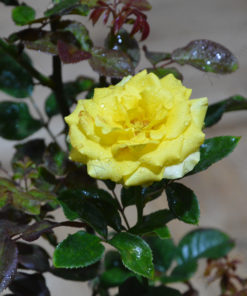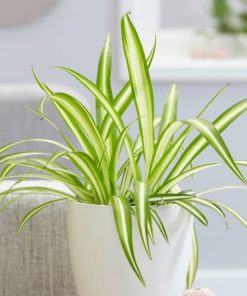Rose (Baby Pink) | گلاب
₨2,976.00 Original price was: ₨2,976.00.₨2,400.00Current price is: ₨2,400.00.
The rose is a perennial flowering plant.The flowers of the rose grow in many different colors, from the well-known red rose to yellow roses and sometimes white or purple roses, peach, orange.
Description for Rose (Baby Pink)
The flowers are densely filled with petals, much like antique roses, and most possess a strong fragrance. English roses are a good choice for cutting gardens.
They are full, intensely perfumed flowers make sumptuous bouquets. Some varieties climb if left unpruned and can be trained along a fence or arbour.
The symbolism of rose colours is steeped in tradition. Roses inspired people over thousands of years to develop a language of colour.
| Common name | Flower colours | Bloom time | Height | Difficulty |
|---|---|---|---|---|
| Damask Rose, gulab | Baby pink | Annual | 1 to 6 feet | Easy to grow |
Planting and care
When you bring rose plant and cannot plant it immediately, leave the plant in the box and lightly sprinkle the roots every day. Do not let the roots to dry out. Plant the rose plant as soon as possible. If cannot plant it immediately to the desired location, plant it in a container.Dig a planting hole according to the roots, the rose plant has.
If it is 2 yrs, then dig a planting hole at least 6 inches deeper, so the roots of the plant can be accommodated without crowding or bending. Mix some fertilizer (cow manure or organic compost) with the soil in the planting hole, plant the rose plant carefully, spread its root and fill with soil. Firm the soil tightly around the plant.
If the rose plant is not so old and has fewer roots then dig a lesser deeper planting hole.
Cut a stem from a rose plant. Mix fertilizer with some soil, add little water to this mixture and make a firmly tight lump at one end of the stem.
Dig a planting hole (index finger deep) place the stem with lump side down, fill with soil. Firm the soil tightly. Keep the soil moist continuously for 2-3 weeks.
| Sunlight | Soil | Water | Temperature | Fertilizer |
|---|---|---|---|---|
| Full sun, Partial sun | Rose is grown in well-drained soil with a sunlight. Clay or loamy soil is ideal. | Keep soil moist throughout the growing season. | 10 degrees C and above | During active growth and blooming stage, rose plants need more fertilizing. The plant need frequently feeding and generously.
Cow manure is best preffered as fertilizer for the rose plants, but other organic fertilizers like compost are also used. Rose plants requires 2-3 times feeding during the season. |
Caring for Rose
- Roses, especially the repeat flowering varieties, need a generous supply of nutrients regularly through the growing season.
- Slow release or organic fertilizers applied to the ground are the most effective; however foliar feeds are also valuable for a quick effect and to help keep the leaves healthy.
- Mulching with organic matter (a very wide range is available) is a very important part of rose growing, helping to conserve water, keeping the ground cool and feeding the micro organisms and worms in the soil.
- It should preferably be well rotted and, if it starts to disappear during the season, be reapplied.
- The best way to keep your plants free from pests and diseases is to choose disease resistant varieties and to grow them as well as possible.
- Regular watering is essential, the rose will be stronger, healthier and, most importantly, produce more flowers.
- Early spring is the best time to prune. If it is still winter, your overeager cuts may lead to frost damage.
- Pruning is pretty straightforward: Remove all non-negotiable growth, thin the plants, and then shape them.
- Experts advise cutting 1/4 inch above a bud eye so the bud eye does not dry out.
Typical uses of Rose
Special features:
Culinary use: Rose hips are occasionally made into jam, jelly, marmalade, and soup or are brewed for tea, primarily for their high vitamin C content. They are also pressed and filtered to make rose hip syrup.
Rose petals or flower buds are sometimes used to flavor ordinary tea or combined with other herbs to make herbal teas.
Ornamental use: Roses are best known as ornamental plants grown for their flowers in the garden and sometimes indoors. They have been also used for commercial perfumery and commercial cut flower crops. Some are used as landscape plants, for hedging.
The majority of ornamental roses are hybrids that were bred for their flowers. A few species of roses are grown for attractive or scented foliage.
Medicinal use: The rose hip, usually, is used as a minor source of Vitamin C. The fruits of many species have significant levels of vitamins and have been used as a food supplement. Many roses have been used in herbal and folk medicines. Some species have been used for stomach problems, and are being investigated for controlling cancer growth.
Note: The following information is general guidelines. Be sure to ask your healthcare provider for guidelines.
References
- https://en.wikipedia.org/wiki/Rose
- http://www.bhg.com/gardening/plant-dictionary/rose/english-rose/
- https://www.davidaustinroses.com/american/Advanced.asp?PageId=2006
Be the first to review “Rose (Baby Pink) | گلاب” Cancel reply
You must be logged in to post a comment.
Only logged in customers who have purchased this product may write a review.
See some of our delivered orders by Clicking here
Applicable on Plants Only: As plants are diverse in appearance, the image is for reference. The plant delivered may vary in size. Price is according to the plant size delivered.
"For Plants Only " All our plants come in living room ready condition in a high quality plastic pot. See The PotRelated products
Outdoor Plants
IMPORTED: Chinese Banyan | Ficus Microcarpa Nitida | پانڈا فائیکس | فائیکس مائیکروکارپا
Indoor Plants
Indoor Plants
Indoor Plants
Indoor Plants
Indoor Plants
Indoor Plants













Reviews
There are no reviews yet.